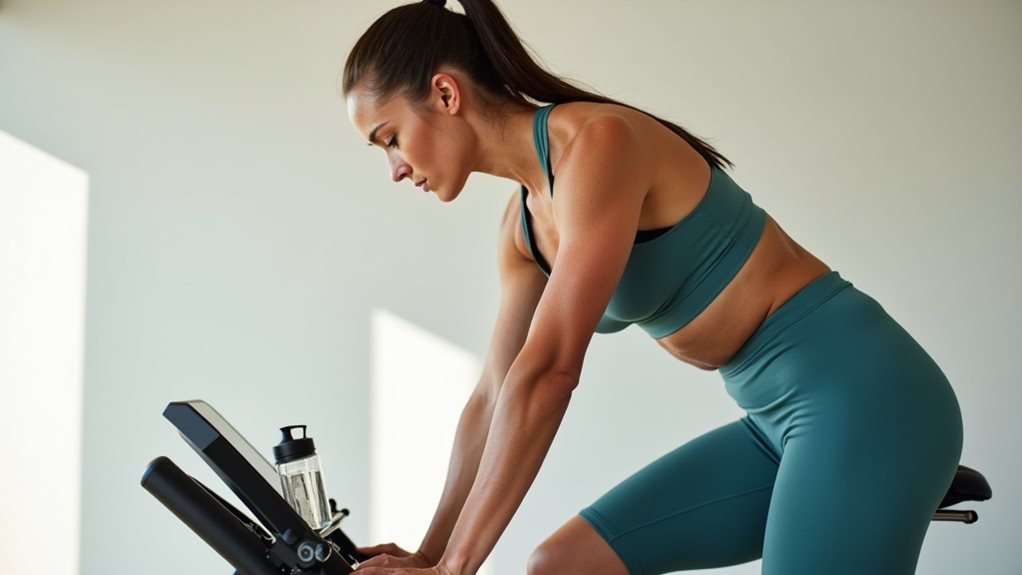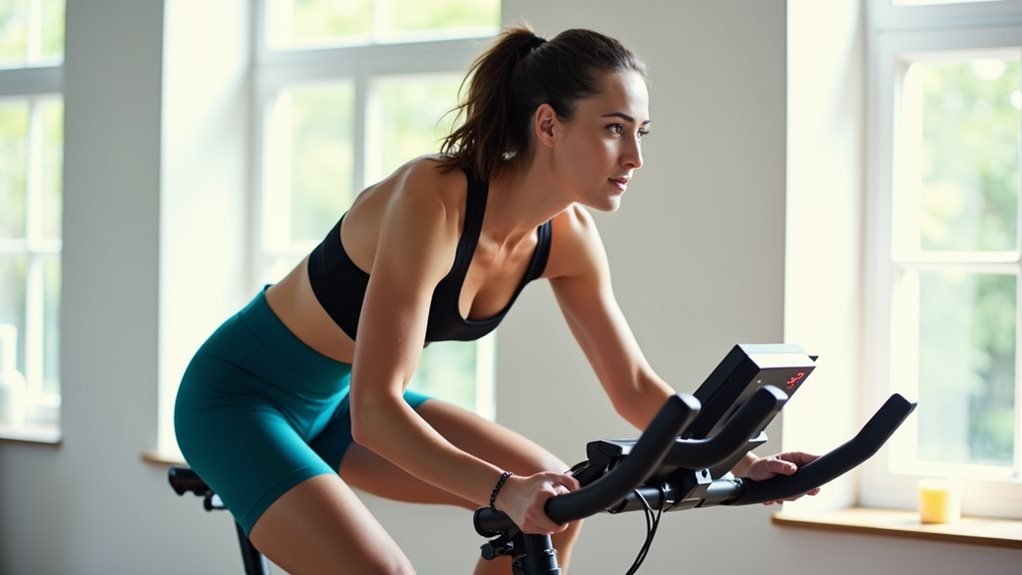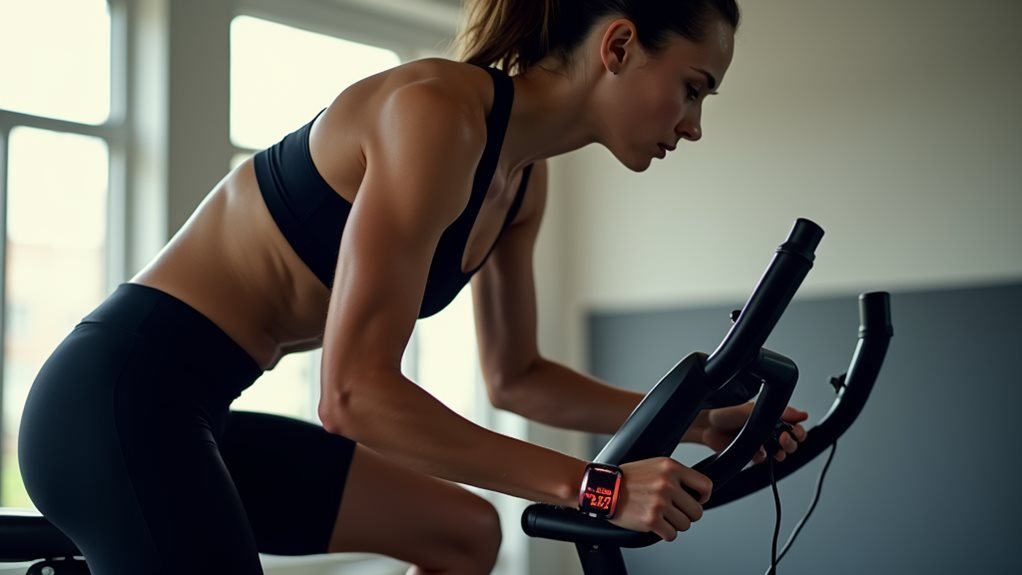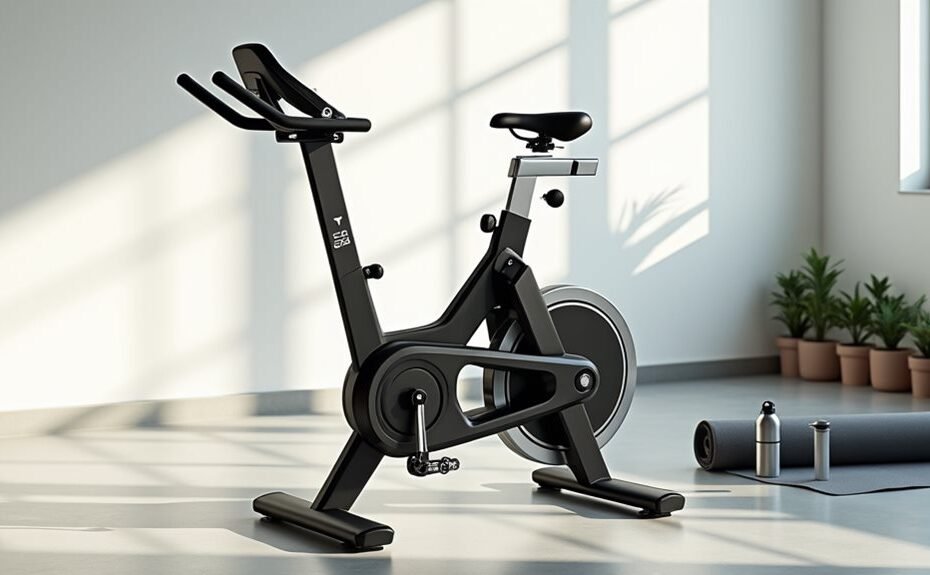I'd like to share my insights about HIIT stationary bike workouts, a training method that's transformed my approach to cycling and fitness. As a cycling coach, I've seen how this time-efficient workout style can deliver impressive results in less time than traditional cardio sessions. Whether you're a beginner looking to jumpstart your fitness journey or an experienced athlete aiming to break through plateaus, HIIT cycling offers a customizable path to reaching your goals. Let me show you how to harness the power of high-intensity intervals to maximize your workout potential.
Key Takeaways
- HIIT cycling alternates intense bursts of pedaling with recovery periods, creating efficient workouts that improve cardiovascular fitness in 20-30 minutes.
- Beginners should start with a 5-10 minute warm-up and simple intervals, progressing to advanced protocols like Tabata as fitness improves.
- Maintain proper form by securing feet, adjusting handlebars, and alternating between seated and standing positions for optimal muscle engagement.
- Monitor heart rate to ensure high-intensity periods reach zones 4-5 and recovery periods stay in zones 2-3.
- Track progress through improved endurance and speed, adjusting workout intensity and duration while staying attentive to body signals.
What Makes HIIT Cycling Different
In contrast to traditional cardio, HIIT cycling creates distinct physiological responses that set it apart from other forms of interval training. When I compare cycling HIIT to running intervals, I've found that cycling actually produces higher levels of physiological stress, as shown by increased oxygen consumption and deoxyhaemoglobin levels in the muscles. The time-efficient nature of HIIT cycling makes it an excellent choice for those with busy schedules.
I'll tell you what makes cycling HIIT unique: it activates more muscle groups and demands greater systemic oxygen utilization than running intervals. You'll notice higher heart rates and likely feel that it's more challenging, as evidenced by higher ratings of perceived exertion. While you mightn't enjoy it as much as running intervals, the intensity leads to significant benefits. Research shows that participants typically report lower enjoyment levels during cycling HIIT sessions compared to running.
The physiological demands of cycling HIIT are particularly interesting because they stem from differences in absolute workload. Your muscles need more oxygen during cycling intervals, shown by increased oxyhaemoglobin and deoxyhaemoglobin levels in the working muscles.
This higher oxygen demand creates a more intense cardiovascular response, making cycling HIIT an especially effective workout for improving cardiorespiratory fitness.
Getting Started With HIIT Cycling

Starting a HIIT cycling journey requires careful preparation and understanding of basic principles. I recommend getting medical clearance first, especially if you're older or have any chronic conditions. Before your first session, make sure you're properly hydrated and fueled.
Your workout will typically last about 20 minutes, including warm-up and cool-down periods. I suggest starting with six 30-second sprints at 40% of your peak power output, followed by three minutes of active recovery between each sprint. You'll want to aim for an intensity that puts you at about 85% of your peak heart rate during the high-intensity intervals. These workouts can help reverse biological aging by up to 20 years when performed consistently. Research shows that older adults benefit significantly more from high-intensity training compared to moderate exercise routines.
Monitor your exertion using the RPE scale, targeting a rating of 15 or higher on the 6-20 scale during intense periods. I've found that tracking your heart rate and RPE helps guarantee you're working at the right intensity while staying safe.
Plan to do these workouts every five days for six weeks, totaling nine sessions. Remember to progress gradually – there's no need to push too hard too soon. As you advance, we can adjust the intensity to match your improving fitness level.
Designing Your Perfect HIIT Workout

Designing your ideal HIIT cycling workout requires careful attention to both structure and intensity. I recommend starting with the classic Tabata protocol: 20 seconds of all-out effort followed by 10 seconds of rest, repeated for 8 rounds. As you progress, you can experiment with different interval structures, like 30:30 or 20:40 work-to-rest ratios. This low-impact exercise makes it suitable for everyone regardless of fitness background.
I'll help you customize your workout based on your fitness level. If you're a beginner, start with shorter high-intensity periods and longer recovery sections. Monitor your heart rate to make sure you're hitting zones 4-5 during intense intervals and zones 2-3 during recovery. As your fitness improves, increase the intensity periods and reduce recovery time. Limiting sessions to 2-3 times weekly helps prevent overtraining and injury.
To add variety, I suggest incorporating pyramid intervals, where you gradually increase then decrease intensity throughout your session. You can also simulate hill climbs by adjusting resistance levels or try finish-line drills with out-of-saddle sprints. Remember to include proper warm-up and cool-down periods. For added challenge, combine your HIIT cycling with strength training exercises, creating a thorough workout that targets multiple fitness goals.
Maximizing Results Through Proper Form

Now that you've designed your workout structure, proper form will maximize your results and prevent injury on the stationary bike. I'll show you how to maintain best positioning throughout your workout.
Start by securing your feet firmly in the pedals and adjusting your handlebars for support. If you're using an AirBike, engage your arms with the moving grips to activate more muscle groups. During your ride, I recommend alternating between seated and standing positions, especially during sprint intervals, to target different muscle groups and maintain involvement. A proper 5-10 minute warmup at moderate pace is essential before starting your HIIT intervals.
Your pedaling technique is vital – focus on smooth, controlled movements while maintaining proper resistance levels. For beginners, I suggest starting with seated positions on a recumbent bike for added stability. Focusing on effort over speed will ensure a more effective workout. As you progress, you'll want to monitor your heart rate to make sure you're working in the correct zones during both work and recovery periods.
Remember to adapt your form based on the intensity. During high-resistance climbs, lean slightly forward and grip the handlebars firmly.
For sprints, keep your core engaged and your movements controlled, even when fatigue sets in.
Beyond Basic HIIT Cycling Techniques

Once you've mastered basic HIIT cycling techniques, I'll guide you through advanced methods that'll transform your workouts.
I recommend starting with variable intensity training, where you'll alternate between moderate cycling for one minute and 30-second sprints. This builds a solid foundation for more challenging protocols like Tabata, which pushes you through 20 seconds of maximum effort followed by 10 seconds of rest. During these sessions, proper hydration levels are crucial for maintaining peak performance.
For structured progression, I suggest incorporating pyramid intervals into your routine. You'll start at a low intensity, gradually increase to your maximum effort, then decrease back down. This approach helps you maintain control while pushing your limits. These structured indoor sessions are ideal since they provide controlled resistance for precise intervals.
To complement this, I've found that 5×5 workouts – five sets of five-minute all-out efforts – notably boost endurance.
I always emphasize the importance of heart rate monitoring during these advanced techniques. You'll want to hit zones 4 or 5 during high-intensity periods and recover in zones 2 or 3. Remember, you can customize these workouts by adjusting interval lengths, resistance levels, and recovery periods as your fitness improves.
Frequently Asked Questions
Can I Do HIIT Cycling While Pregnant?
Yes, I'll tell you that HIIT cycling during pregnancy is safe if you were already doing it before. Get your doctor's approval and modify intensity as needed throughout each trimester.
How Many Calories Does a Typical 20-Minute HIIT Cycling Session Burn?
I'd estimate you'll burn 260-384 calories in a 20-minute HIIT cycling session, depending on your weight. At 125 pounds, expect around 260 calories; at 185 pounds, about 384 calories.
Should I Eat Before or After HIIT Cycling Workouts?
I recommend eating both before and after your HIIT cycling. Have a light carb-rich snack 1-2 hours before, then consume protein and carbs within 30 minutes after for best recovery.
Is HIIT Cycling Safe for People With Knee Problems?
I'd say HIIT cycling is typically safe for knee problems since it's low-impact, but you'll need proper bike setup and form. I recommend consulting your doctor first and starting gradually.
Can HIIT Cycling Help Improve Running and Swimming Performance?
Like a rising tide lifts all boats, I can tell you that HIIT cycling will boost your running and swimming performance by improving your VO2max and building endurance with low-impact training.
